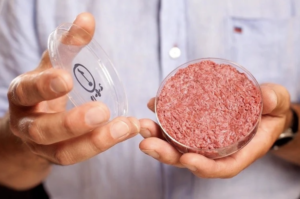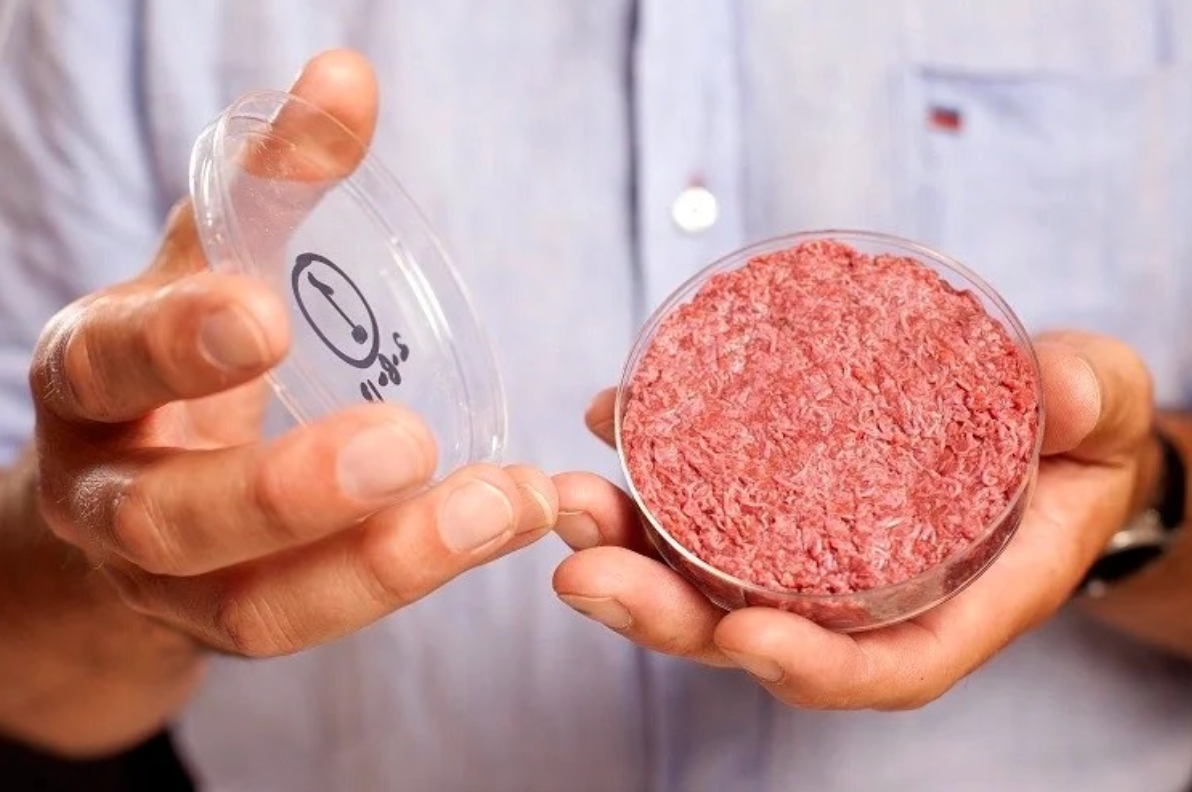In the long past when hunting was a necessity to stay alive, for anyone to consume meat, one had to directly become a predator. When meat turned into a market product it started as a luxury good in most parts. Only in the past century, we’ve seen a new phenomenon of the rise of factory farms that now dominate the production and supply of meat. From humans hunting and often being hunted in history, we are now the biggest and the most organized predator, with around 70 billion land animals and countless sea creatures being killed every year. There are locations where meat burgers, once a luxury good, is cheaper than its veggie counterparts. In any of these phases over time, it is like a natural rule that for meat to be produced, animals will need to be killed. In the 21st century, however, there seems to be a new phenomenon that holds the potential to put this natural norm into a close with the production of slaughter-free meat.

Cultured Meat. Picture By ‘Mosa Meat’
In 2013, the first Lab Meat was publicly tasted. In a nutshell, it’s produced through the nurturing of stem cells that are multiplied to form muscle tissues. It’s cultured to be the same as the meat tissue that comes from animals. The cost of the first Lab Meat by Mosa Meat was around 250,000 Euros, and it may have been the most expensive meat ever tasted. 7 years from then, in 2020, Singapore took it a step further being the first country to sell lab meat in the market. According to Reuters, by 2021, ‘Mosa Meat’ says it hopes to sell its lab-grown patties at around $10. It is expected that the prices will keep getting lower over time. On the other hand, plant-based meat which happens to be the most common meat substitute at the present is growing in its prominence quite well, especially in the western world. Brands like Impossible Burger and Beyond Meat have introduced plant-based meat that many have claimed to be a potential revolution in the industry.
This new phenomenon wouldn’t have been of significance if it weren’t for its underlying context. The current method of meat production has several indisputable issues that seem extremely hard to fix. The industry practices are far from ‘humane killing’ of animals, with many animals raised in unpleasant conditions and exposed to terrible methods of slaughter. The world has seen the rise of several movements against big factory farms and new debates over time concerning the ethics of meat consumption. While around 70 billion animals are slaughtered every year, it is hard to make an estimate of how many animals live at any point in time for the purpose of consumption. It is now well noted that there’s an enormous amount of resources (food, water, land) that is required for the rearing of these animals that can come at a compromise to concerns about environmental sustainability. Even in the subject of Global Warming and Climate Change, factory farming has started receiving its share of accusations with claims that they account for a large share of carbon emissions.
Despite the numerous diagnosis of the harms that factory farming and livestock pose on the planet, the wellbeing of animals, and that of humans, the solutions still don’t seem compatible with the demand of the market. The wish that the entire world will go meat and dairy-free as a solution to existing problems, though has garnered tremendous support in the past decade, still seems to be a utopian dream far from home.
If Lab Meat gains prominence in the market, which I assume will in the long run, it might as well be the case that the nature of meat production that currently takes place will be irrelevant in the future.
There is certainly enough demand for the product to make a mark in the market at the moment. Whether or not it will be able to compete well with general meat is something to look forward to. It is well predicted that Lab Meat will be ‘cleaner’ in the sense that it will be exempt from the harms of animal meat caused due to antibiotics, disease, and poor-raising environments, which can make Lab Meat a healthier option. Ethically, it shouldn’t be a matter of debate on which of the two is a better choice. There are several concerns over the likely emission of greenhouse gases from large-scale production of Lab Meat, however, there’s enough optimism that it’s an area that the growing technology will keep fixing over time.
When Lab Meat attains a strong position in the market, assuming that it does over time, I think it is likely that countries that have attained a level of animal rights consciousness among the public will roar higher demands than other parts of the world. It’s also likely that the product will face tensions in penetrating nations where the market is legally influenced by strong religious beliefs. I think those struggles will be temporary and in the longer run, like in the case of many other things, people’s education and new perspectives allied with the demands of the market will overcome traditional ideas and beliefs. As plant-based meat gained prominence, big brands tapped into it quite quickly. I would guess that the same is likely in the case of Lab Meat as it offers the potential to be sold as guilt-free real meat. It would be safe to assume that Animal Rights Movements will have a new force in their lines of advocacy. I assume that as Lab Meat and Plant-Based Meat gain a level of prestige in the market, there will be a shift in the priorities – from the call to “reduce meat consumption” to “opt into alternatives”.
Several surveys have shown skepticism among people regarding consuming meat that is grown in a lab. It should be fascinating to see how things turn out to be once the product marks its presence in markets around the world. As technology is making access to many areas of our lives, I think lab-grown meat along with plant-based meat is the future of meat in general. If it works out well, it shall be the beginning of liberating animals from the misery that’s forcibly imposed upon them, and also liberate humans from being a predator in the way we currently are.






